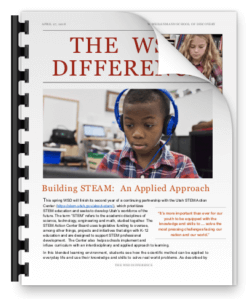Congratulations to Middle School Math Teacher, Jessica Hunsaker, who was recognized by the Utah State…
8. Building STEAM: An Applied Approach
 This spring WSD will finish its second year of a continuing partnership with the Utah STEM Action Center, which prioritizes STEM education and seeks to develop Utah’s workforce of the future. The term “STEM” refers to the academic disciplines of science, technology, engineering and math, studied together. The STEM Action Center Board uses legislative funding to oversee, among other things, projects and initiatives that align with K-12 education and are designed to support STEM professional development. The Center also helps schools implement and infuse curriculum with an interdisciplinary and applied approach to learning.
This spring WSD will finish its second year of a continuing partnership with the Utah STEM Action Center, which prioritizes STEM education and seeks to develop Utah’s workforce of the future. The term “STEM” refers to the academic disciplines of science, technology, engineering and math, studied together. The STEM Action Center Board uses legislative funding to oversee, among other things, projects and initiatives that align with K-12 education and are designed to support STEM professional development. The Center also helps schools implement and infuse curriculum with an interdisciplinary and applied approach to learning.
In this blended learning environment, students see how the scientific method can be applied to everyday life and use their knowledge and skills to solve real world problems. As described by the US Department of Education, “… it’s more important than ever for our youth to be equipped with the knowledge and skills to solve tough problems, gather and evaluate evidence, and make sense of information…to think deeply and to think well so that they have the chance to become the innovators, educators, researchers, and leaders who can solve the most pressing challenges facing our nation and our world, both today and tomorrow….These are the types of skills that students learn by studying science, technology, engineering, and math—subjects collectively known as STEM.”
STEM education aligns with the mission and vision of WSD in preparing students with 21st century skills such as problem solving, critical and analytical thinking, and the ability to work independently as well as collaboratively. “One of the ways we support STEM education at WSD,” explains Executive Director Cindy Phillips,“is through our association with the STEM Action Center. We have just signed up to pilot a program in 2018-19 for new STEM micro credentials for teachers and were informed that WSD has one of the highest uses of any school in the state — 82% — on the STEM Action Center Professional Learning Tool.”
Other evidence of our commitment to STEM is a new math curriculum implemented in Lower School this year. After seeking and winning the State Systemic Improvement Grant, WSD was able to purchase the Bridges in Mathematics curriculum, a program that fosters deep understanding of mathematical concepts and blends direct instruction, structured investigation, and open exploration. The rigor, method, and engagement of this program matches that of the College Preparatory Math (CPM) curriculum utilized in Middle School.
WSD is also a three-year recipient of the Digital Teaching and Learning Grant, and has applied those funds to increase the number of Chromebooks in each grade level. Integrating technologies into the core curriculum, emphasizing project-based and inquiry-based learning, and teaching robotics, coding, and environmental and outdoor science are other ways STEM education is supported at WSD.
With a solid foundation in STEM, WSD is moving more deliberately into STEAM — the A is for Arts — with a planned expansion of two new science labs and two new art studios of more than 950 square feet each over the next two years. The expansion will include flex space with traditional spots for digital learning and project-based learning, as well as collaborative spaces for professional learning communities in both STEM and STEAM. “We embrace the practice that no subject should be taught in isolation,” Cindy maintains. “Critical, ethical, and logical thinking reside inside the Humanities, and innovation, design and technology are an integral part of the Sciences — and they work best together.” Without distracting from the primary purpose of each discipline, STEAM has the potential to enhance student engagement and unlock creativity and innovation across the curriculum. “STEAM education, which is both collaborative and interdisciplinary, teaches students how to solve real world problems and prepare for future careers in a way that traditional methods simply cannot.”
At WSD we see obvious examples of STEAM at work in science fairs, Lower School exhibitions, student art installations, and other events where students prepare artifacts over an extended period of time while integrating multiple subjects and skills. On a daily basis, student learning is infused with STEAM as a natural component of project-based learning. In fact, STEAM at its best is project based-learning, offering students opportunities to create, collaborate, problem-solve, think critically, learn experientially, and value their world — and their place in it.











